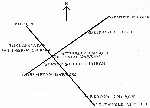
Barsham Stone No authoritative statement appears to be handed down the ages regarding “these stones” (Joshua iv. 21) but the following quotations included in our Secretary’s paper are illuminating even if they are not quite applicable. From Suckling’s Suffolk, re Gorleston:
